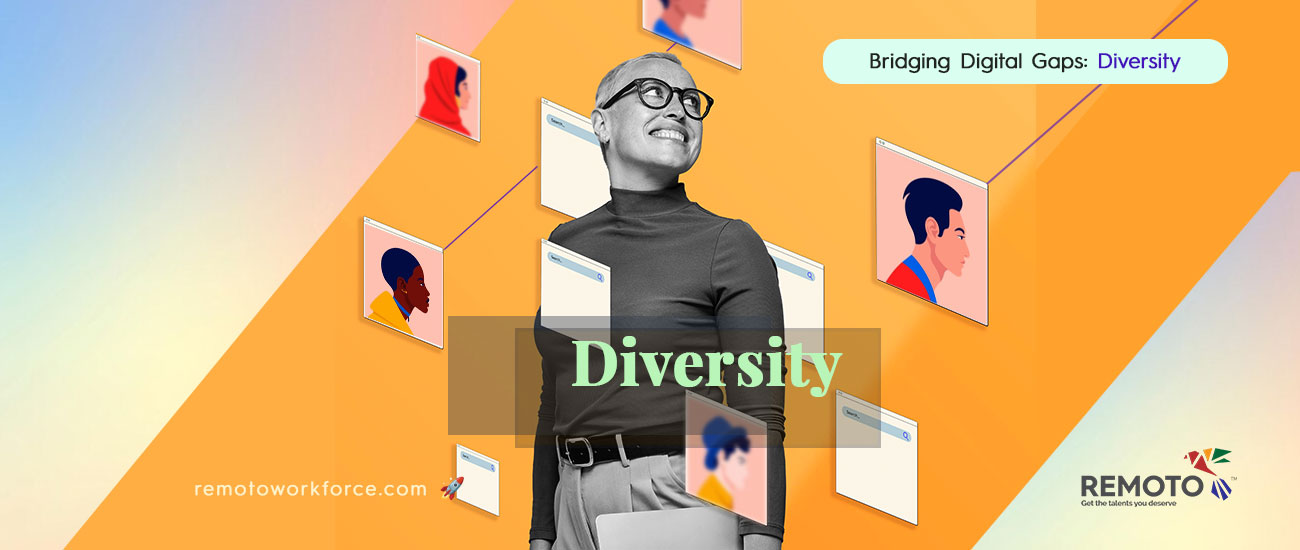The rise of remote work in recent years has shattered traditional workplace models. Fueled by globalization and unforeseen events like the pandemic, this shift has redefined where and how work gets done. While this digital revolution unlocks a world of opportunity from attracting top talent anywhere to fostering a more flexible work-life balance – it also presents challenges.
One critical hurdle is the persistent digital divide. This gap in access a technology and digital literacy skills can leave entire groups of workers behind, hindering both the effectiveness and inclusivity of remote work environments.
As we embrace this new era of remote work, a focus on diversity an inclusion is no longer a nicety; it’s a strategic move.
By ensuring everyone has the resources and support they need to thrive in a remote setting, regardless of background and location, we unlock the full potential of global workforce. This fosters innovation, boosts employee satisfaction, and propels organizations towards long-term success.
How do we bridge the digital divide and create a truly inclusive remote work environment? Let’s explore how to understand digital gaps, its relationship with diversity, and actionable strategies to promote access and literacy.
Understanding Digital Gaps
The term “digital divide” refers to the disparity in access to and use of technology between different groups of people. In the context of remote work, this translates to a gap between those who have the resources and skills to thrive in a remote environment and those who face challenges due to limited access or knowledge.
Here are some key aspects of the digital divide that hinder successful remote work.
- Access to technology: This includes reliable internet connection, suitable devices like laptops or tablets, and software subscriptions. Remote workers without these resources face significant difficulty completing tasks, collaborating effectively, and staying connected.
- Digital literacy: Even with access to technology, a gap in digital skills can be a major hurdle. This refers to the ability to comfortably use technology, including video conferencing tools, project management platforms, and communication software. Remote workers who lack digital literacy may struggle to learn new tools, navigate complex workflows, and participate fully in a virtual work environment.
- Socio-economic barriers: Cost often plays a significant role in the digital divide. Individuals from lower socio-economic backgrounds may struggle to afford reliable internet access or up-to-date devices. Additionally, access to quality education and training in technology can be limited, further widening the gap.
The impact of these digital gaps falls disproportionately on diverse groups, including:
- Marginalized communities: People of color, individuals with disabilities, and those living in rural areas often face greater challenges in accessing technology and acquiring digital skills.
- Underrepresented communities: Women and minorities may be underrepresented in certain fields where remote work is more prevalent, potentially exacerbating existing inequalities.
By recognizing how these digital gaps impact diverse groups, organizations can develop strategies to bridge the divide and create a more inclusive remote work environment.
The Intersection Between Digital Gaps and Diversity
Digital gaps don’t exist in a vacuum. They often intersect with existing inequalities in the workplace, creating a double bind for diverse groups struggling to thrive in remote work environments.
Consider this scenario: A single mother from a low-income background lands a coveted remote work position. However, she lacks reliable internet access at home and struggles to afford childcare while attending online meetings. This is just one example of how digital gaps and pre-existing disparities can combine to create significant challenges.
Intersectionality is key. Addressing digital gaps effectively requires acknowledging how they interact with other forms of workplace inequality. A one-size-fits-all solution won’t work. Companies need to consider the unique challenges faced by diverse groups and develop strategies to provide targeted support.
When you recognize and address intersectionality in the workplace to bridge the digital divide, you can foster a more inclusive and equitable remote environment for everyone.
Do you want to deeper your understanding about the digital divide? Watch this video!
Strategies for Bridging Digital Gaps
While the digital divide presents a significant challenge, there are actionable strategies the private sector can implement to bridge the gap and create more inclusive remote work landscape. Do you want to learn more? Here are some strategies you can implement in your company:
- Government initiatives: Public programs can offer subsidized internet access and discounted devices to low-income families and communities. Additionally, funding initiatives for digital literacy training programs in schools and community centers can equip individuals with the necessary skills to navigate technology effectively.
- Non-profit partnerships: Collaboration between non-profit organizations and technology companies can provide access to refurbished devices and training programs focused on building essential digital skills for the workforce.
- Technology stipends: Companies can offer financial assistance to employees for purchasing equipment upgrades or securing reliable internet connections.
- Flexible work schedules: Providing flexibility in work hours can help employees with childcare or other responsibilities that might make traditional video conferencing schedules challenging.
- Training and support: Developing comprehensive training programs on remote work tools and best practices for virtual communication can empower employees with the necessary skills to succeed.
- Accessibility features: Using video conferencing platforms and project management tools with built-in accessibility features ensures everyone can fully participate, regardless of ability.
By adopting these strategies, you can create inclusive remote work policies that acknowledge the digital divide and provide the resources and support necessary for a diverse workforce to thrive in a virtual environment. This not only fosters a more equitable workplace but also unlocks the full potential of a global talent pool, driving innovation and success for companies.
Takeaway
Remote work has transformed how we work, opening doors to a global talent pool and flexible schedules. However, there are digital divides that affect how remote employees access to Internet, develop tech skills, or use the right devices. You can bridge this gap by working with your local government, non-profit organizations, and other partners to create policies with stipends and support for everyone.
Ready to take action? Contact Remoto Workforce to build a future that’s innovative and accessible for all.














